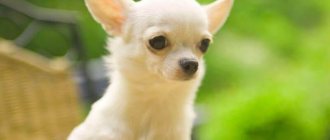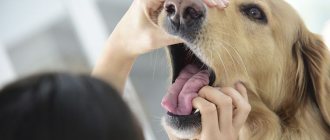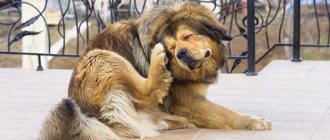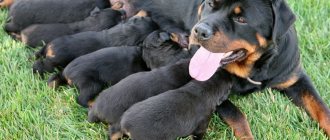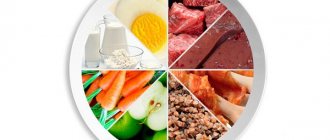Dental diseases affect not only people, but also their four-legged pets. Moreover, to treat the latter, it is always necessary to use general anesthesia, which requires mandatory rehabilitation. To maintain oral health, it is necessary to understand at what age dogs lose teeth for physiological reasons, and when you should consider contacting a veterinarian.
How many teeth should a dog have?
A healthy dog should have exactly 42 of them. Exactly 20 grow on the upper jaw, and 22 on the lower jaw. These include:
- 4 fangs;
- 10 molars;
- 12 incisors;
- 16 premolars.
The bite plays a big role in maintaining integrity. Minimal wear and tear is characteristic of the scissor style, which is the gold standard for most breeds.
The puppy lost a tooth
Have you noticed that your puppy's behavior has changed? Does he chew on everything he can fit in his little mouth? Perhaps he is more irritable than usual? Has your baby completely lost his appetite, has problems going to the toilet, or has his body temperature risen?
Most likely, the baby is preparing for the fact that the first baby tooth is about to fall out. Like people, dogs undergo the same change from baby teeth to molars. Babies are born completely toothless, and only at the end of the first month of life do the first 4 milk fangs appear. Then, by three months, 12 incisors grow, and lastly, 16 premolars. After reaching the age of approximately 3-4 months, it is time to replace baby teeth with permanent ones. Molars or, as they are correctly called, molars will appear only after the milk teeth are replaced with permanent ones. At the age of 6-7 months, dogs already have a full set of 42 molars.
This change occurs in the same way as in children: the root of the baby tooth gradually dissolves, moreover, it is pushed from below by the permanent one. The pet experiences discomfort. He wants to “scratch his gums.” This cannot be prevented in any way, and therefore the presence of special toys is extremely necessary during such a period so that the baby does not begin to spoil the furniture, shoes and other things that come into his field of vision. It happens that permanent teeth grow next to milk teeth, this is especially observed in those breeds whose chewing muscles are poorly developed. They are usually brachycephalic (breeds with short muzzles), so be vigilant and remember that teeth that do not fall out at the right time should be removed.
By the way, in large breeds these changes often occur faster than in medium and small representatives of the canine world. The process of changing teeth can take months. This is the time to pay special attention to the puppy’s oral hygiene; it is possible that you will have to massage the gums.
You need to examine the mouth every day, and if an inflammatory process occurs, contact a veterinary dentist. If you “miss” the formation of the masticatory apparatus, then the bite will subsequently develop incorrectly, and this will affect the gastrointestinal tract. By the way, you can also forget about first places at exhibitions and championships. It is also worth adding that the habit of gnawing foreign objects, thereby rendering them unusable and inappropriate, can also remain for a long time.
You can also help the little one and carefully, using, for example, gauze, pull out a baby tooth that is “hanging by a thread.” There shouldn’t be a lot of blood, and it clots quickly. If the bleeding does not stop, contact your doctor immediately.
We should also mention the vaccinations that need to be done before the teeth begin to change. It is also better to refrain from operations during this period, since, for example, docking the ears or tail will help prolong an already unpleasant period in the dog’s life. Try not to overexert your puppy with walks and physical activity. The immune system is weakened at this time. The baby can easily catch a cold and get sick, and this is fraught with complications due to such changes in the body.
Despite the fact that your pet needs increased attention, do not forget that changing teeth is a natural process that you and I have also gone through. Collecting fallen fangs as a souvenir is completely unnecessary, and it is not always possible. In fact, it can be almost impossible to keep track of when puppies lose their baby teeth. Many owners do not even notice when and how this happens. Puppies try to taste everything: where they bit, that’s where they leave the baby tooth.
Normal Cases of Tooth Loss in Dogs
Tooth loss in dogs and puppies is accepted as normal only in 2 cases: when changing milk production and when old age sets in. In all other situations, the help of a veterinarian is required.
Changing teeth in puppies
On the x-ray you can see that all babies have as many as 2 rows of teeth. At the very bottom is the root one. It replaces the milk one after its roots have dissolved. Complete renewal is completed by the end of the first year of life.
The responsible process proceeds differently for everyone. Some puppies experience mild discomfort, suffering from itching and a slight fever. Others behave completely normally, so their owners notice the loss only during cleaning.
The help of a veterinarian in this situation is required only if there is a delay from the standard schedule - or if alarming symptoms appear. The most dangerous include the smell of rot, heavy bleeding and fainting.
The onset of old age
It is impossible to answer exactly at what age a dog’s teeth fall out due to old age. Everything here is very individual. Some pets manage to maintain the integrity of both jaws until death. In most cases, this is due to careful oral hygiene and good genetics.
In old age, the ligamentous apparatus that holds the dentition inside the sockets weakens, so it begins to loosen and fall out. Increased wearability also plays a significant role.
Sometimes breaking off occurs right at the root, leaving only a tiny fragment in the hole. In such situations, the pet should be taken to a veterinary clinic, since remaining particles can cause inflammation.
Formation of the dentition
Before we understand the causes of tooth loss in adult dogs, let's familiarize ourselves with the anatomy. Puppies, like small children, are born with empty gums. Their first teeth appear at 1 month of life. They are called “needles”. After two to four weeks, the rest will emerge. Puppies do not have molars in their first bite. A complete row of primary teeth consists of 32/28 pieces. Their number may vary depending on the breed of dog. In the first case, each jaw will have 16 teeth, in the second – 14. It is worth noting that they can appear at different times in puppies not only of the same breed, but even of the same litter. The norm is a difference of 7-14 days.
Let's look at the order in which teeth erupt:
- milk fangs – on the 20-25th day;
- incisors – on the 30-40th day;
- premolars appear from the 35th day of life to the 60th.
In decorative dog breeds, the first teeth erupt only on the 40th day of birth. Moreover, this delay applies to the entire dairy range.
Possible pathologies
A mandatory examination by a veterinarian is required at the moment when an adult dog’s molars begin to fall out. If her age is far from elderly, then the cause of the disorder lies in pathology.
Oral diseases
Dental diseases affect soft mucous or hard bone tissue. The most common diseases include the following:
- caries
– putrefactive destruction of hard tissues, often complicated by periodontitis and pulpitis;
- periodontitis
– an inflammatory process involving the connective tissue between the hole and the root;
- pulpitis
– inflammation of internal tissues, including nerves and blood vessels;
- stomatitis
– damage to the oral mucosa;
- gingivitis
– an inflammatory process that covers exclusively the gums and does not affect external soft tissues;
- periodontitis
– a complication of gingivitis that affects all surrounding tissues.
All these diseases require mandatory treatment, since very often they are complicated by secondary infections. Also, when the process is running, the likelihood of losing not only part, but the entire dentition increases.
Bacterial and viral infections
Bacteria and viruses that enter the mouth directly or from neighboring organs are usually to blame for the occurrence of the pathologies discussed. Their waste products cause acute intoxication. The body uses an inflammatory response to destroy the pathogen.
Improper feeding
When feeding exclusively soft foods, the gums soften, causing premature loosening. There is also a rapid accumulation of plaque, which gradually hardens into stone. The quality of enamel deteriorates, causing the development of caries.
Eating tubular bones is no less dangerous. They injure soft tissues, opening the way for pathogens.
Injuries and tumors
The cause of the problem can be severe maxillofacial injuries associated with mechanical damage. In this case, the animal loses its snow-white smile immediately upon being hit or bruised.
It is also recommended to check the dog for the presence of tumors. Malignant tumors have a destructive effect on the mucous membranes.
Features of prevention
Regular prevention allows you to timely identify the presence of oral diseases in a dog or prevent their development:
- Information awareness. It is necessary to know whether puppies lose teeth and at what time this happens. Knowing the age intervals allows you to track tooth loss or remove an interfering tooth in a timely manner.
- Examination by a specialist. Dogs are shown to veterinarians and dentists once a year. An examination is mandatory during and after changing teeth. It allows you to identify malocclusion and carry out treatment.
- Load on the jaw. Dogs require regular stress on their jaw. It is created during active games. Rubber toys and special treats can help.
- Oral hygiene. Dogs are taught hygiene from an early age. To clean your teeth, use a special paste and brush. Daily cleaning is the norm.
- Features of feeding. Dogs must be fed solid ingredients. A natural diet should include bones and rawhide products. When feeding, preference should be given to dry mixtures.
- Dangerous items. During active games, you should not use sharp, metal or glass objects that can injure the mucous membranes or damage the teeth.
From an early age, dogs must be taught oral hygiene.
The loss of one or more teeth in adulthood can negatively affect the dog’s health and provoke the development of various diseases. Therefore, it is important to regularly conduct preventive examinations and accustom your pet to hygiene procedures from an early age.
Associated symptoms that help determine the cause of the problem
If your dog has loose teeth, you need to pay attention to the accompanying symptoms. It is from them that you can make a preliminary diagnosis and understand how dire the current situation is:
- unpleasant odor, small holes, brown or black spots on the enamel – caries;
- sharp pain when biting, the presence of fistulas, swelling of the gums and muzzle - periodontitis;
- pain on palpation, chewing strictly on one side and refusal of cold food - pulpitis;
- increased salivation, redness of the mucous membranes and a brown-white coating on the tongue - stomatitis;
- bleeding during meals, the presence of small ulcers in the mouth - gingivitis;
- exposure of roots, leakage of pus and inflammation of the submandibular nodes - periodontitis;
- curvature of the bite, swelling and the appearance of blood from the mouth and nose - injury;
- the presence of suspicious growths in the oral cavity, sudden weight loss, oral bleeding - malignant neoplasms.
If you notice these symptoms, be sure to seek help. Tests will be required to determine the exact cause. Until this moment, you can only alleviate the pet’s condition by revising its diet to a more gentle one.
Risk group by breed
The risk group includes small representatives of decorative breeds. With a normal dentition size, their jaw is more compact in size and has thin bone. Such animals include:
- Spitz;
- toy terriers;
- chihuahua;
- Yorkies;
- Pekingese;
- Japanese chins.
In addition to the genetic predisposition to the listed pathologies, such pets often suffer from persistence - an unusual anomaly in which both dentitions are preserved. This problem can only be solved surgically.
What to do if your dog's teeth fall out
Methods for treating the resulting pathology directly depend on the root cause. It can only be determined after diagnosis.
Passing diagnostics
In addition to a visual examination, the four-legged pet will need to undergo an x-ray and a Schiller-Pisarev test. The first research method determines the degree of damage to bone tissue, and the second determines the presence of an inflammatory process.
Depending on the diagnosis, the animal undergoes ultrasonic sanitation (cleaning) of the oral cavity, splinting, or removal of the problem organ. Additionally, a number of drugs are prescribed to treat the root cause and eliminate its consequences.
Drug treatment of the underlying cause
Antibiotics and antiviral drugs are used to destroy bacteria and viruses. The duration of such therapy takes about 10 days.
In addition to the main treatment, symptomatic treatment is also used. Depending on the clinical picture, the four-legged patient may be recommended the following medications:
- antiseptics;
- enzyme agents that improve the digestion process;
- painkillers;
- anti-inflammatory;
- immunomodulators.
Tumors are treated based on their degree of malignancy and type. Anti-blastoma drugs and chemotherapy are used to suppress their growth. But the most effective way remains their excision, used strictly before the appearance of metastases.
Prescribing a special diet
First of all, you should avoid sugar-containing products that are on the prohibited list. Many owners commit the sin of feeding from the table, but this bad habit needs to be gotten rid of.
During treatment, the pet is fed wet food or ground natural products. Solid foods necessary for bone health are introduced only after the root cause has been eliminated and the condition of the oral cavity has normalized. Cartilage, dry biscuits, carrots and spongy bones cope well with the resulting plaque.
Splinting
This method is used to prevent loosening and strengthen the remaining teeth. Under general anesthesia, the four-legged patient is given a wire or fiberglass that connects the damaged organs to the healthy ones.
Such a prosthesis is inserted for injuries and periodontitis. Its shelf life ranges from 1 month to several years. After this time, the outdated design is replaced.
What happens if your pet loses teeth?
Even a significant loss affects the chewing process. In addition to unpleasant sensations and a high probability of complications in neighboring tissues, periodic problems from the gastrointestinal tract are observed. The whole point is that the food that gets there is poorly ground. Because of this, the stomach and intestines require more strength to digest it.
As a result of massive loss of teeth, the animal's bite is disturbed, which makes it unsuitable for participation in exhibitions. Such a pet has to be switched to soft and liquid food, which can cause new complications from the gums.
Prevention and oral hygiene
To avoid problems with the oral cavity, it is necessary to regularly examine its integrity and pay attention to hygiene. It is recommended that dogs at risk be taken to the dentist for examination every six months in order not to miss the development of disorders.
When changing teeth in puppies
If your puppy's teeth are falling out, buy him a teether. By cooling the water it contains, itching and inflammation can be significantly reduced.
A beautiful and healthy bite requires a lot of calcium and phosphorus, so be sure to add the following products to your weekly menu:
- raw carrots;
- cheese, cottage cheese, kefir and other low-fat fermented milk products;
- boiled cartilage;
- veal;
- fish oil and sea fish;
- beef liver;
- sea buckthorn oil.
It is better to discuss the introduction of ready-made vitamin complexes with your veterinarian. Otherwise, you can provoke the development of hypervitaminosis.
Cleaning with brush and paste
Brushing should be taught from early childhood, when the baby’s first baby incisors are just beginning to appear in his mouth. The procedure is carried out once a month or every 2 weeks. More frequent cleanings are prescribed by a veterinarian if there is a predisposition to oral diseases.
The enamel is cleaned with a special brush, placed directly on the finger, and veterinary paste or cleaning gel. Most products have a pleasant meaty taste, making the training process easier.
Conclusion
If your dog has lost a tooth and its condition leaves much to be desired, be sure to contact a veterinary clinic for help. Thanks to timely diagnosis, it is possible to prevent further loss, preserving the integrity and health of most of the dentition.
The article is for informational purposes only. Contact your veterinarian!
Preventive actions
Prevention of tooth loss is extremely simple:
- It is necessary to regularly inspect the dog's mouth, especially if a foreign, unpleasant odor begins to appear.
- If you suspect the development of inflammation, immediately contact a veterinarian.
- Regularly clean your teeth from plaque using special brushes and pastes, as well as using special gelatin or stringy bones or special food. Store-bought cleaning products can be replaced with natural beef or veal knuckles.
- Have the accumulated tartar cleaned regularly by specialists.
- Do not feed dogs only soft food (especially pates).
- Monitor the process of changing teeth in small dogs, in which it is difficult due to the anatomical features of the jaw structure.
- Provide a dog that lives permanently in an apartment with special toys or devices that it can simply chew on, thereby training its jaws.
Author:
Grinchuk Ekaterina Andreevna veterinarian


